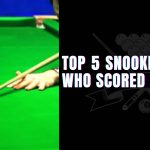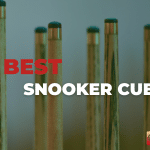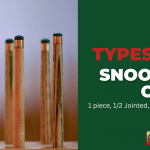How To Choose A Snooker Cue
Table of Contents
There is such a huge variety of Snooker cues available in the market that you can easily be overwhelmed by the huge variety. The main thing while choosing a Snooker cue is that you should be satisfied with your choice. Be it for a professional game or hobby, you have to be content with the quality of the cue that you will play with.
It is good to listen to others’ advice, but the best way to choose the perfect cue is to research it yourself. If you still can’t decide how to choose a snooker cue, worry not! We have made a short guide that can help you with the decision of buying a cue.
Learn more about the snooker cue and pool cue differences, here.
What to look for when buying a snooker cue
The first thing that snooker players have to ponder is how to choose a good snooker cue. A snooker cue is a piece of wood that has been molded to a specific weight and length. When choosing a snooker cue, factors such as the type of wood used, the craftsmanship, the level of attention to detail, and your budget are very important. You have to be fully satisfied with your cue to give your best performance. If you are not fully satisfied with the cue you are playing with, it will definitely affect your game.
When it comes to Snooker cues, everyone has their own preferences, some go mainly for looks while others may look for a specific weight or length. You may not necessarily like what others consider the best, so you definitely have to look for different types of snooker cues, that you will be most comfortable with. There are various factors that you will need to keep in mind for your cue selection, which has been listed below.
1. Material
The material of the cue is another important factor that you have to consider while choosing a snooker cue. The greatest snooker cues (especially the shaft) are manufactured from firm rock maple wood with a straight grain or the more readily available ash wood. You can also choose from a wide range of other woods, such as rosewood and snakewood used in more extravagant cues. The grain lines, colors, and textures will vary across various species of wood.
In addition to the cue material, the wrap material is also an important factor to consider while choosing a pool cue. To find the wrap that best suits your style of play, try out a variety of wraps, such as linen, leather, nylon, or even a wrap-less cue. Apart from the wooden cues, there are also many modern alternatives that you can consider including fiberglass cues and graphite cues. We advise selecting a snooker cue that is sturdy, manageable, and comfortable for you.
Whatever material you choose while buying a snooker cue, one thing that should always keep in mind is making sure that you clean your snooker cue shaft consistently to elongate the cue’s life.
Maple
In general, maple is regarded as one of the best type of snooker cue. As opposed to ash, maple is denser and tougher, allowing for a stronger shot. In pool, a strong break can be extremely important in starting a good game. However, maple’s major asset is its longevity. Maple is a sturdy wood that resists warping, bending, and cracking. Because of this, maple pool cues can be used and played with frequently for a long time without losing their quality. A decent wood contributes significantly to how sturdy and long-lasting your cue can be, in addition to proper maintenance and storage.
Additionally, because maple is relatively cheap, manufacturing expenses for cues and consequently consumer purchasing costs are kept lower than with more expensive types of wood. This is advantageous for those who must purchase a range of cues. Due to the much denser grain of maple, any surface grime and filth from your hands, etc., tend to accumulate on the surface more quickly since it is not as easily absorbed into the wood. This makes maple cues more likely to need wiping.
As opposed to ash, maple typically has a brighter yellow hue and less pronounced graining. If you want a plain shaft, maple is definitely a better option. Similar to ash, the color of maple can range from extremely pale to extremely dark depending on the surrounding environment. Both will have a wide range of colors, some being light and others being dark. Both ash and maple are fully capable of giving you a full spectrum of shots and differ in terms of weight; nevertheless, as with everything else, choice is a matter of personal preference. Some people like maple, while others prefer ash.
Ash
Ash is used to make more than 95% of the premium cues currently available. Even while it isn’t frequently utilized in the American pool, it is one of the most popular snooker cue in billiards games. This is because the lighter balls used in these games make up for the lighter ash wood’s disadvantage when striking the heavier balls used in the American pool.
Ash is thought by many players to have a better touch or feel than maple. Many players believe that they are more precise and stronger because of their lightweight and less dense nature, which makes it simpler to shoot extremely quickly. Some players also enjoy the ash wood’s texture.
Ash has a really pronounced grain and is quite stiff. It is more porous than maple and hence tends to feel drier, making it an excellent choice for players who frequently have extremely sticky hands. Ash has also distinct grain patterns and is sometimes favored by players because it contains chevrons or arrows that they can use to line up shots.
However, sometimes, it oftentimes isn’t perfect, which makes it difficult for the player to play the shot straight. Although the grain often darkens with age, some ash cue producers apply dye to intentionally create the antique effect. The color of the graining can be dependent on the age of the cue, but this is not always the case.
2. Splicing
Another thing to consider while choosing a snooker cue is splicing. Both one-piece and jointed cues typically have a different, heavier wood, like ebony, spliced into them because it creates a stunning contrast with the ash or maple. The butt splice is currently made from a variety of woods, including rosewood.
Traditional cues are four-point spliced, meaning that ebony or some other wood is fused into the shaft at four different spots. The various splices available now include butterfly point, 8 point, and 10 point. Many producers of 9 ball cues employ 8 or 10 point because they are thought to produce stronger, stiffer, and hence more accurate cues.
Sometimes the butt section may also be painted on rather than spliced and which indicates that the wood is not genuinely real. For example, a snakewood decal is likely to be a transfer or paint job that mimics snakewood but is not actually snakewood. While it may be true that the cue is obviously less expensive to construct, it does not necessarily follow that it will play any worse than a genuine cue made from ebony and snakewood.
The one drawback of this kind of cue is that if you damage the surface, the less expensive wood will show through. The reality of the situation is that there are many different types of wood available for use in snooker cues; the only factor that truly matters is how well-seasoned the wood is.
Machine Splice or Hand Splice
The main difference between machine slice and hand splice is their appearance. The spliced points on hand spliced cues are somewhat rounded, whereas, they are pointier and sharper on machine spliced cues. Hand-spliced cues are generally more expensive than machine ones. Machine spliced cues are better now than before as they have better accuracy than the ones in the past. The main thing to keep in mind is your comfort level while deciding between hand or machine spliced while choosing a cue stick.
3. Joint position
Snooker cues can be classified into three primary categories: one-piece, three-quarter, and two-piece jointed. A single square of wood is used to create a one-piece cue. One-piece cues cannot be disassembled because they lack joints. Whereas, two-piece and three-quarter jointed cues can be disassembled by simply unscrewing their joints.
These cues are perfect for playing at home. Traditional one-piece cues are popular among players because they provide a more reliable hit; nevertheless, it all depends on your personal preference. You can look at all these options while choosing a cue stick.
Three-quarter jointed and two-piece cues are also excellent choices. These days, three-quarter jointed cues are becoming more popular. A three-quarter jointed cue that is properly constructed will play similarly to a one-piece cue and have a powerful hit as well. The three-quarter cue’s main advantage is that, in comparison to one-piece cues, it is not at all awkward to hold and has a shorter cue and case. They are also more portable as compared to one-piece cues.
When it comes to cue conveyance, two-piece jointed cues are equally as advantageous as three-quarter jointed cues, but there is a significant drawback. The middle joint in the jaw can lock up while cueing, and because it’s on the inside, a little portion of the cue’s hit is deflected away by the joint.
4. Cue Length
One of the biggest concerns that people have when it comes to choosing a cue stick is deciding on the cue length. The majority of snooker cues available online are 58 inches in length, with the weight ranging from 16.5 to 20 ounces. Though one would think a longer cue would provide more space to grip, having a long cue has some downsides as well. Players that are 6’4’’ and taller can use longer Snooker cues given they have the necessary physical strength.
As the cue length increases, the balance point shifts towards the butt section and the stick gets heavier. Both of these factors are important for a player to keep in mind while selecting their cue length. The majority of the time, you have to hold behind the balancing point, which keeps the stick’s tip up when held in your bridge hand. Any balancing adjustment, even one-half of an inch, affects how the stick feels.
Snooker players tend to use cue lengths that are around 5 inches shorter than their own shoulder level. You can first consider starting with a 60-inch Snooker cue and adjusting the length to your desire if you want to enhance your game or challenge yourself to become a better player.
5. Cue Weight
Cue weight is another important factor to consider while choosing a Snooker cue. There is no ideal weight for the cue stick but there are various effects that increasing or reducing your cue weight can have. If the cue is too light, it can be hard sometimes to control the cue shots. It can also get somewhat unsteady and can affect your game while playing. You can also consider having a heavier cue to check your control. Selecting the optimal cue weight can take some time as players also keep shifting between lighter and heavier over their playing career.
Most manufacturers and even professionals choose cues with a weight between 430g and 500g. When you get a custom snooker cue, this is the weight that you will most likely be suggested. If you are a beginner, then you should focus more on the weight you feel most comfortable with. Choose the cue that feels neither too heavy nor too light and feels just comfortable in your hands.
6. Cue Tip
Thickness and hardness are the two main characteristics to pay strict attention to when choosing the best type of snooker cue. The hardness of tips varies, ranging from ultra-soft to as hard as the cue ball itself. Whether you choose a playing cue or a breaking cue, the hardness of the snooker cue tip you choose depends depend on your playing style. Each cue tip has its own unique characteristics and applications and depending on your preferences, both small and large cue tips may prove to be particularly well suited to your playing style.
Larger tips cover a larger surface area when they come in contact with the ball. With a larger tip, your odds of striking the cue ball’s center are higher and your margin of error is smaller. Smaller tips are ideal for increasing shot speed, and there aren’t any significant drawbacks to the size decrease. Using a smaller tip necessitates greater skill. A smaller tip might also make the ball spin more quickly even when you don’t want it to. This is due to the cue ball’s surface not having enough tip coverage, which causes an uneven spin.
The tip of the cue is the most crucial component even though the cue itself must feel comfortable because it has the power to make or break your play. The dimension, surface area, hardness levels, and styles of cue tips vary. Cue tip hardness is another factor that you have to consider. Since soft tips absorb more impact, they stay on the cue ball for a fraction of a second longer than harsher tips.
A softer tip would remain on the cue ball more after contact with the cue ball than a hard tip would. Softer tips tend to deform more easily and require more maintenance to maintain a pleasingly adjusted shape. Softer tips are also needed to be replaced with additional support. Compared to soft tips, hard tips produce less spin and are more likely to miscue when striking the cue ball outside of its center. Hard tips can be much more dependable to play, and they also last longer and need less assistance.
A harder tip may last longer than a softer one, but if it is not properly cared for, the surface may become glossy and lose its ability to create friction with the ball. A softer tip will likely corrode more quickly from abrasion and tend to collapse on contact, throwing the ball off course.
Does the Cue Price Matter?
No matter how good or expensive a cue is, your skill level will determine how good you are at the game. Many people purchase expensive cues, and some even go so far as to have cues made for them made by specialists, although this does not improve their performance in any game that uses cues. So, to answer the question; does a good snooker cue make a difference? Yes, it does, but you don’t have to empty your pocket and budget in order to get the most expensive cue out there. You have to remember that a cue is merely a tool, and how you utilize it entirely depends on how proficient you are with that instrument. A beginner will hardly be able to distinguish between a cue used in snooker clubs and one created by Parris Cues. So, just focus on looking for what works the best for you!








Thanks for your blog, nice to read. Do not stop.